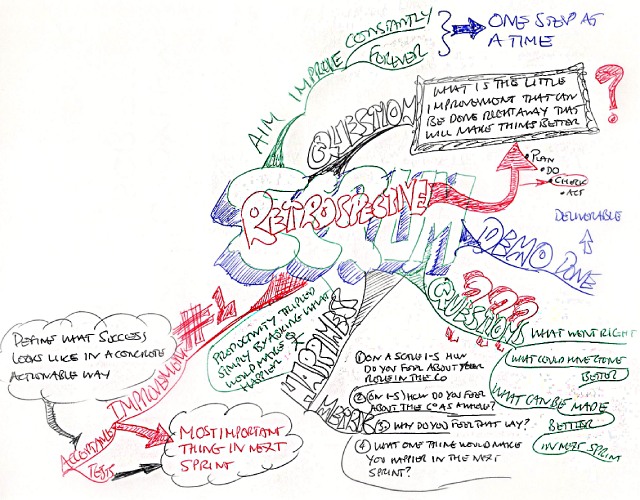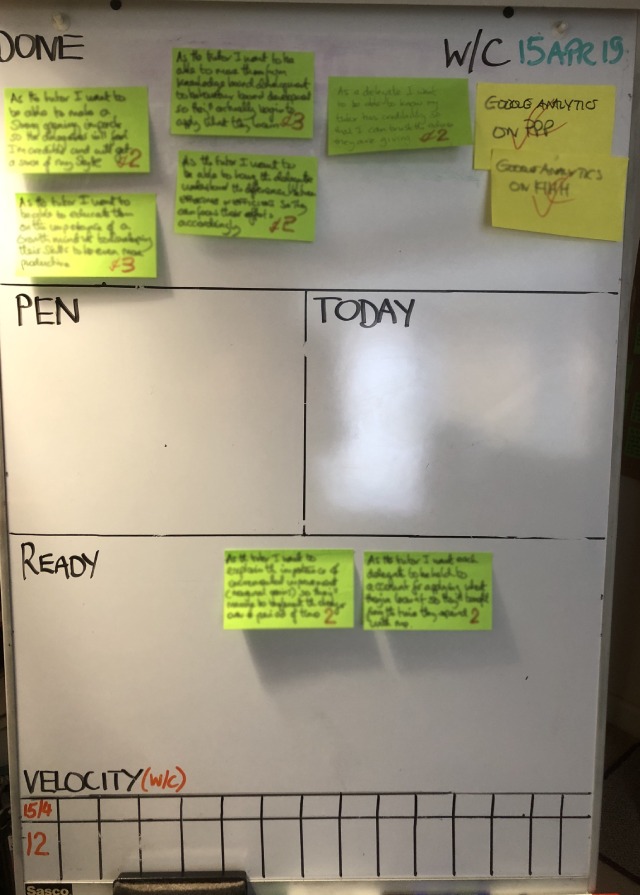
In This Episode…
Last week I had my first sprint for my project to create my productivity seminar I’m running in a few months time. In today’s episode I take you through the principles of a Sprint Retrospective and conduct my own for last week’s effort.
It was a busy week with a lot of progress made on my project, plenty of good things that happened and a lot of lessons learnt. I review them all and share what I am going to do to make next week even better.
Episode Show Notes
In a previous episode, (012 SCRUM Update 01 – Initial Backlog Created, Estimation Complete, Sequencing Begun And I’m Ready To Start) I talked about planning my first SCRUM sprint. In this episode I take you through my first Retrospective.
00:39 – The key components of a sprint retrospective (taken from Jeff Sutherland’s SCRUM – The Art Of Doing Twice The Work In Half The Time)

00:49 – The aim of the SCRUM approach is constant and never ending improvement in the way work is carried out. It is done one step at a time. The key question to ask is this:
What are the little improvements that can be done right away that will make things better?
Jeff Sutherland, SCRUM – The Art of Doing Twice The Work In Half The Time
01:42 – The aim of a sprint is to produce a working deliverable that can be presented to the customer.
02:43 – The review part of the retrospective looks at the following three questions:
- What went right?
- What could have gone better?
- What can be made better in the next sprint?
03:09 – I am working on my own for this project and so going through these questions will be an easy and straightforward task. However, in a project team, the team culture needs to allow the giving of open and honest feedback and the maturity to accept it. It is important to note, these questions are about unearthing things to be improved and not to apportion blame.
05:11 – Jeff Sutherland describes his “Happiness Metric”. He believes that people work better when they are happy and so he wanted to track that. To do so he came up with these four questions:
- On a scale of 1-5, how do you feel about your role in the company?
- On a scale of 1-5, how do you feel about the company as a whole?
- Why do you feel that way?
- What one thing would make you happier in the next sprint?
06:01 – Jeff Sutherland used this approach to triple the productivity in his business. He found the Happiness Metric to be an accurate leading indicator of potential problems affecting productivity.
08:11 – The next thing the retrospective does is identify the number 1 improvement to be incorporated into the next sprint. This is how a focus on constant improvement is implemented. Perfection might never be achievable, but you can get closer and closer by chipping away at the imperfections in the working processes and adding improvements along the way.
08:43 – A key thing about the number one improvement for the next sprint is to ensure success is defined in a concrete and actionable way. This is an important point I missed on the first two times I read the SCRUM book.
09:13 – I begin my retrospective on last week’s sprint.
09:58 – Here is what I was able to demonstrate as a working deliverable:
- A mini module on the Growth Mindset
- An explanation of the importance of shifting from knowledge based development to behaviour based development
- A mini module on the differences between efficient and effective.
- Evidence to help my seminar participants have confidence in my credibility and ability to help them develop their productivity.
- The outline framework of my seminar presentation.
13:15 – What worked well this week?
- Investing in a professional Keynote Slide Deck template.
- 14:09 – Focusing each day on achieving a specific outcome.
- 14:43 – Using large flip chart paper to collate and process my research.
- 15:40 – Developing my slides alongside my developing content.
- 16:36 – Using a Kanban board to track the progress of this week’ sprint.

- 17:34 – Developing my skills in creating graphics in Keynote.
19:04 – What could have gone better?
- Perhaps outsourcing the graphics is something I should consider even though I do benefit from the convenience of being able to edit them myself.
- 19:30 – The user story definition needs to be clearer.
- 20:18 – I need to number each story to make it easier to reference (e.g. Story 37).
- 21:05 – Define what done looks like for each of my stories. So far I have not done that.
- 21:27 – I had planned for a 5 day sprint forgetting Friday is my Power Day used for catching up and clearing away loose ends.
- 22:09 – This sprint retrospective was done on Monday Morning instead of at the end of the week.
- 22:52 – The quality of the estimation needs to be improved. A story rated a 3 at the initial backlog creation was probably only a 1. Another story from last week that was a 2 was probably more like a 3 or 4.
23:52 – my velocity for this week (the total of each story estimation rating) was 12. Because I have been tracking my time, I can see that has arisen from 14:45 dedicated project time and 2:08 research time (16:53 in total). I now have my first metric.
25:09 – What am I going to improve this week?
- 25:17 – I will number each of the user stories to make referencing them much easier.
- 25:39 – I shall get clearer on what “done” looks like for each of this sprint’s stories.
- 25:50 – I shall evolve my estimation in light of greater clarity on what “done” looks like.
26:04 – I have set myself up for this week’s sprint by choosing five stories – two I didn’t complete from last week and 3 new ones. Based on the current estimations, if I complete all 5 stories this week, my velocity for the week will be 13.
27:08 – I will keep you updated of how things progress.